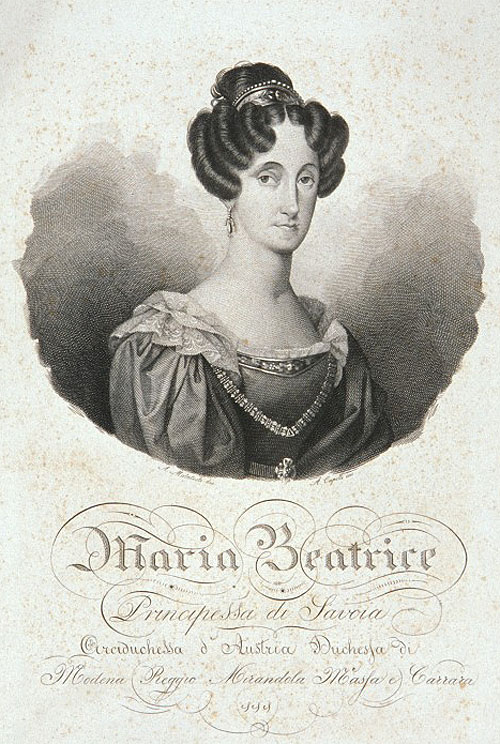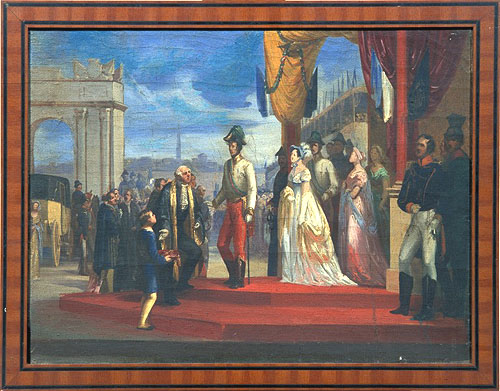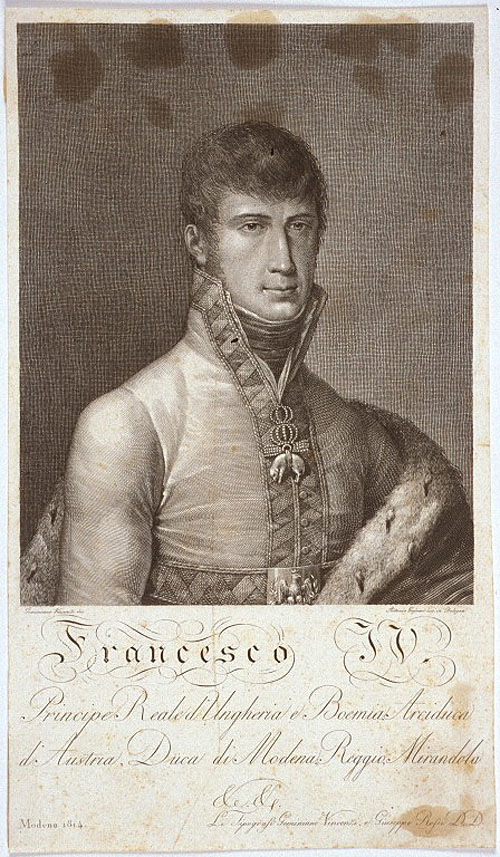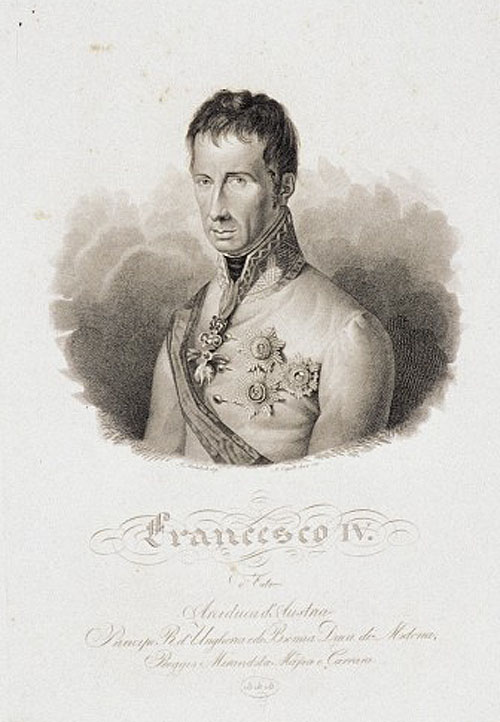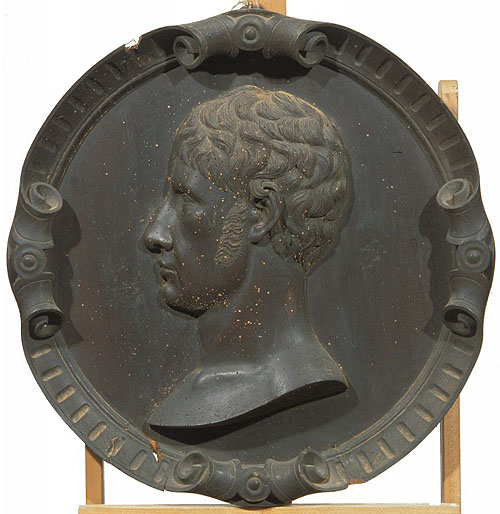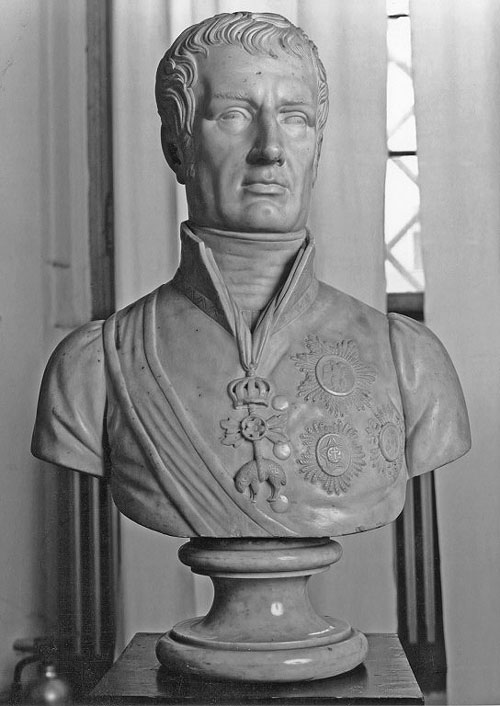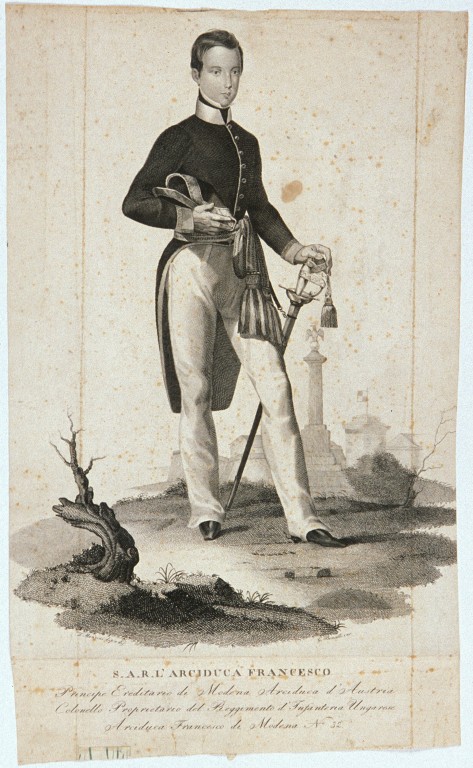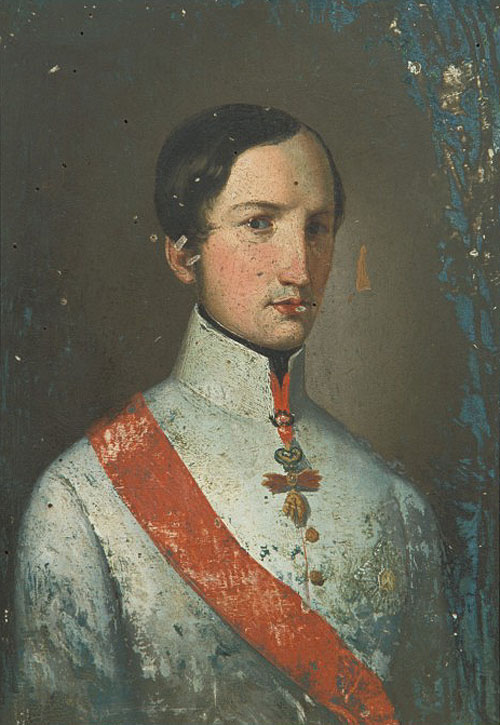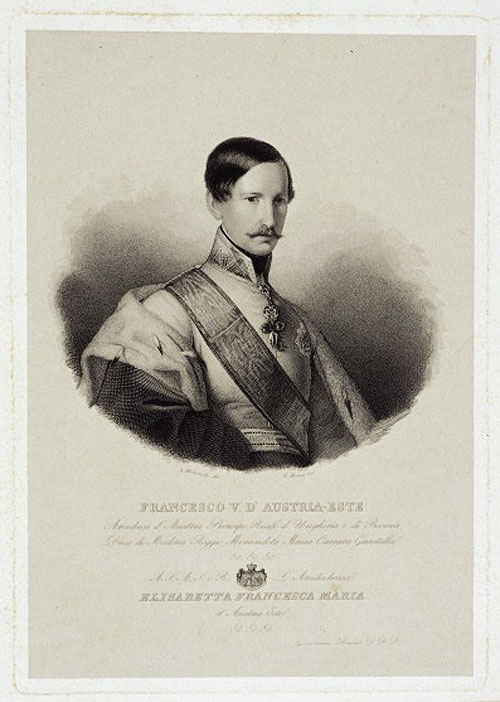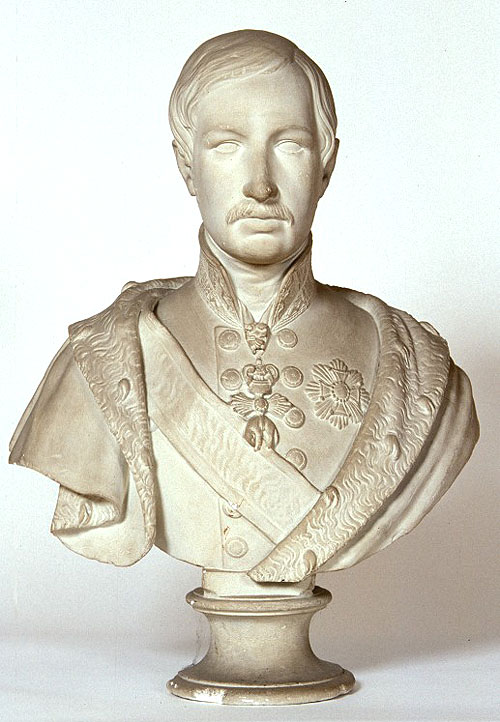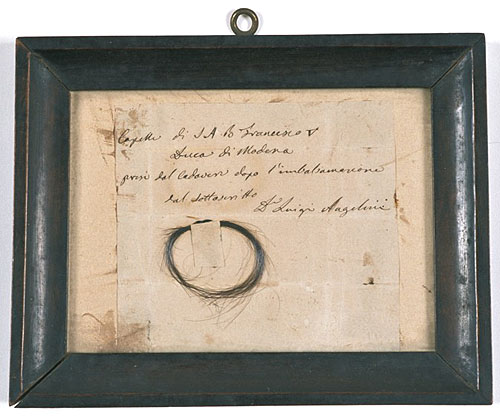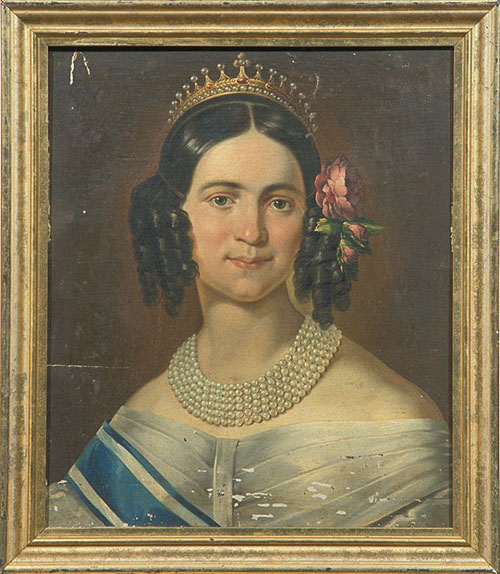 |
 |
 |
 |
 |
 |
 |
 |
 |
|
A Jacobite Gazetteer - Modena
Museo Civico del Risorgimento |
|
This museum has been closed for renovations for over twenty years. It's offices are located in the Palazzo dei Musei. The collections of the museum include a large number of items of Jacobite interest from the reigns of Queen Mary III and II and her son King Francis I. There is an engraving of Queen Mary III and II by Agostino Capelli; the engraving is based upon a portrait by Adeodata Malatesta. 1
There is an oil painting on canvas of Duke Francis IV of Modena and his wife Mary Beatrice (later Queen Mary III and II) at their official entrance into the Duchy of Modena on July 15, 1814. 02 The scene shows Francis and Mary in front of a temporary triumphal arch erected in the town of Nonantola. Francis wears a red-and-green breast sash; an official is presenting him with something held by a page on a cushion. The painting was a sketch for a larger work which was to have formed part of a cycle of paintings on the glories of the House of Este which King Francis I ordered to decorate some rooms in the Palazzo Ducale; another example from this cycle can be seen in the Palazzo Arcivescovile.
There is an oil portrait on canvas of Duke Francis IV of Modena, husband of Queen Mary III and II and father of King Francis I. 3 He is dressed in civilian clothes and wears the neck insignia of the Austrian Order of the Golden Fleece.
There is an engraving of Duke Francis IV of Modena by Antonio Gajani; the engraving is based upon a portrait by Geminiano Vincenzi. 4 Over a military uniform, Francis wears an ermine cape; around his neck hangs the insignia of the Austrian Order of the Golden Fleece.
There is an engraving of Duke Francis IV of Modena by Agostino Capelli; the engraving is based upon a portrait by Adeodata Malatesta. 5 Francis wears a military uniform, with a breast sash and three breast stars; around his neck hangs the insignia of the Austrian Order of the Golden Fleece.
There is an oval wood relief of Duke Francis IV of Modena. 6 His head is shown in profile facing left.
There is a marble bust of Duke Francis IV of Modena. 7 Francis wears a breast sash, three breast stars, and the neck insignia of the Austrian Order of the Golden Fleece.
There is a water-colour on paper of a military parade. 8 In the foreground are two officers on horseback; these are probably Duke Francis IV of Modena and his son King Francis I. They both wear a blue-and-white waste sash and a curved sword (see below). In the background can be seen a flag with the arms of the Duke of Modena (Austria and Este).
There is a full-length engraving of Francis, Duke of Cornwall and Rothesay (later King Francis I) by Giovanni Berselli based on a portrait by Luigi Manzini. 9 Francis is shown as proprietary colonel of the Hungarian Infantry Regiment Archduke Francis of Modena Nr. 32. He wears a waste-sash (sciarpa) and holds a cocked hat (feluca) in his right hand. In the background is a column surmounted by the eagle of the House of Este.
There is an unframed oil portrait on canvas of Francis, Duke of Cornwall and Rothesay (later King Francis I). 10 He wears a military uniform (it appears to be the uniform of a cadet of the Royal Military Academy of Modena).
There is a framed oil portrait on wood of King Francis I. 11 He wears a white military uniform, and the red sash and neck insignia of the Austrian Order of the Golden Fleece.
There is an engraving of King Francis I by Giovanni Bruni; the engraving is based upon a portrait by Adeodata Malatesta. Over a military uniform Francis wears an ermine cape with a breast sash and star and the neck insignia of the Austrian Order of the Golden Fleece. The engraving is dedicated to Francis' sister-in-law Archduchess Elisabeth, wife of Archduke Ferdinand, and mother of Mary IV and III.
There is a gesso bust of King Francis I. 12 He wears an ermine cape and the neck insignia of the Austrian Order of the Golden Fleece.
There is an engraving showing King Francis I, Pope Pius IX, and Monsignor Francesco Emilio Cugini (Archbishop of Modena and Nonantola). 13 The engraving commemorates the visit of Pope Pius IX to Modena July 2-4, 1857. It is based on portraits by Carlo Vandelli, lithographed by O. Nannini.
There is a black wood frame containing a lock of the hair of King Francis I. 14 The inscription states that it was removed from his body after embalming by Dr. Luigi Angelini. 15
There is a sword to which are attached two blue and gold tassels decorated with Francis' monogram (FV) and the eagle of the House of Este.16
There are several blue-and-white waste sashes decorated with Francis' monogram (FV) and the eagle of the House of Este. 17
There is an oil portrait on wood of Queen Adelgunde. 18 She wears a white off-the-shoulder dress and the blue-and-white breast sash of the Order of Merit of the Bavarian Crown. On her head she wears a golden tiara decorated with pearls and rubies. Around her neck hangs a six-strand pearl necklace.
Notes 1 The engraving measures 36.5 cm high and 24.6 cm wide. Agostino Capelli was a Modenese engraver; he produced many engravings of and for the Royal Family, including several in the Albo pittorico di alcune feste modenesi nella fausta occasione delle nozze tra Francesco Ferdinando Principe ereditario di Modena e Adelgonda di Baviera (Modena: Eredi Soliani, 1842). Adeodata Malatesa was born in Modena in 1806 and died in the same city in 1891. Between 1834 and 1852 he painted a number of portraits of different members of the Royal Family as well as paintings on other subjects for the Royal Family. 2 The painting measures 49 cm high and 64.5 cm wide. 3 The portrait measures 26 cm high and 20.5 cm wide. It now has a rectangular frame, but must formerly have been in one with an oval window. The portrait has been identified by the Istituto per i beni artistici culturali e natuarali della Regione Emilia-Romagna as of King Francis I, but the likeness bears a much greater resemblance to that of his father. 4 The engraving measures 27.9 cm high and 16.1 cm wide. Geminano Vincenzi also designed a medal commemorating the return of Duke Francis IV to Modena in 1814; a copy of the medal is owned by the Galleria Estense. 5 The engraving appears to be a companion to the engraving of Queen Mary III and II by Capelli shown above. 6 The relief measures 64 cm high, 62 cm wide, and 7 cm deep. 7 The bust measures 73 cm high, 50 cm wide, and 26 cm deep. 8 The painting measures 39 cm high and 53.5 cm wide. 9 The engraving measures 40.1 cm high and 24.2 cm wide. Luigi Manzini was born in 1805 and died in 1866. He is best known for an oil portrait of King Francis I in the Collegio San Carlo. 10 The portrait measures 55 cm high and 41 cm wide. There is a small possibility that the portrait is of Francis' younger brother Ferdinand (father of Queen Mary IV and III). 11 The portrait measures 39.5 cm high and 28.5 cm wide. 12 The bust measures 70 cm high, 50 cm wide, and 25 cm deep. 13 The engraving measures 40 cm high and 47.3 cm wide. It bears an inscription in honour of Count Luigi Giacobazzi, Minister of State for the Interior from 1848 to 1859. 14 The frame measures 14 cm high and 17.5 cm wide. 15 Dr. Luigi Angelini accompanied King Francis on his trips to the Holy Land in 1864 and 1868. He also attended King Francis in his final illness. 16 The sword is 1.02 metres long. 17 The sashes are approximately 3 metres long. 18 The portrait measures 48 cm high and 40.5 cm wide. All images from the Catalogo dei Beni Culturali della Regione Emilia-Romagna, http://www.ibc.regione.emilia-romagna.it. |
|
This page is maintained by Noel S. McFerran (noel.mcferran@rogers.com) and was last updated October 1, 2006. |
